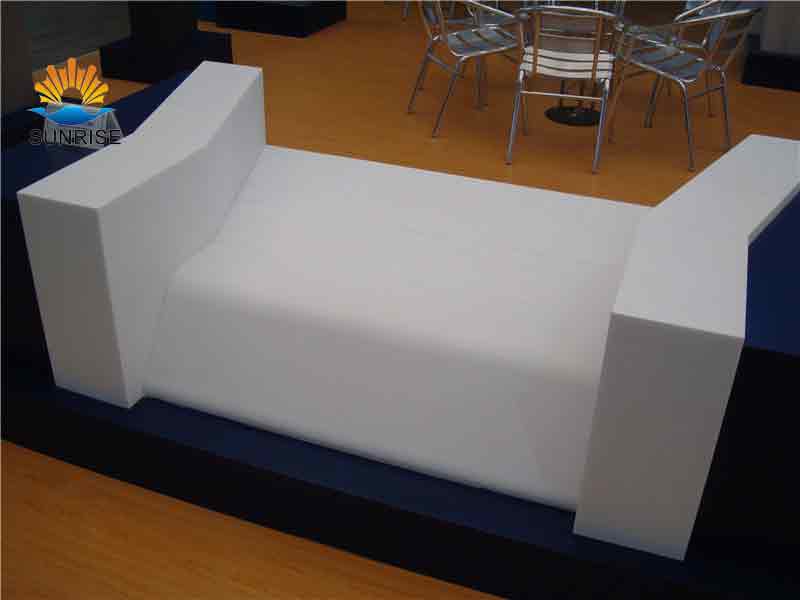Basic Properties Of Corundum Block
Date:2016-02-16 10:04 From:Zhengzhou Sunrise Refractory Author:admin
1) Melting Point:
Melting temperatures (melting points) specify the ability of materials to withstand high temperatures without chemical change and physical destruction. The melting point of few elements that constitute refractory composition in the pure state varies from 3100°– 6300°F
2) Size and Dimensional Stability:
The size and shape of the refractories is an important feature in design since it affects the stability of any structure. Dimensional accuracy and size is extremely important to enable proper fitting of the refractory shape and to minimize the thickness and joints in construction.
3) Porosity:
Porosity is a measure of the effective open pore space in the refractory into which the molten metal, slag, fluxes, vapors etc can penetrate and thereby contribute to eventual degradation of the structure. The porosity of refractory is expressed as the average percentage of open pore space in the overall refractory volume.
High porosity materials tend to be highly insulating as a result of high volume of air they trap, because air is a very poor thermal conductor. As a result, low porosity materials are generally used in hotter zones, while the more porous materials are usually used for thermal backup.
Such materials, however, do not work with higher temperatures and direct flame impingement, and are likely to shrink when subjected to such conditions. Refractory materials with high porosity are usually NOT chosen when they will be in contact with molten slag because they cannot be penetrated as easily
4) Bulk Density:
The bulk density is generally considered in conjunction with apparent porosity. It is a measure of the weight of a given volume of the refractory. For many refractories, the bulk density provides a general indication of the product quality; it is considered that the refractory with higher bulk density (low porosity) will be better in quality.
An increase in bulk density increases the volume stability, the heat capacity, as well as the resistance to abrasion and slag penetration.
5) Cold Crushing Strength:
The cold crushing strength, which is considered by some to be doubtful relevance as a useful property, other than it reveals little more than the ability to withstand the rigorous of transport. It can be seen as a useful indicator to the adequacy of firing and abrasion resistance in consonance with other properties such as bulk density and porosity.
Zhengzhou Sunrise Refractory Co., Ltd. is mainly engaged in the research and development of glass refractory products. Sunrise can provide different shaped excellent refractory such as fused cast AZS block 33#,36#,41#, fused cast alumina block, silica brick, magnesia brick, zircon brick, corundum block, zircon mullite brick, mullite series brick, sillimanite brick, etc. which have passed the ISO international certified.

Melting temperatures (melting points) specify the ability of materials to withstand high temperatures without chemical change and physical destruction. The melting point of few elements that constitute refractory composition in the pure state varies from 3100°– 6300°F
2) Size and Dimensional Stability:
The size and shape of the refractories is an important feature in design since it affects the stability of any structure. Dimensional accuracy and size is extremely important to enable proper fitting of the refractory shape and to minimize the thickness and joints in construction.
3) Porosity:
Porosity is a measure of the effective open pore space in the refractory into which the molten metal, slag, fluxes, vapors etc can penetrate and thereby contribute to eventual degradation of the structure. The porosity of refractory is expressed as the average percentage of open pore space in the overall refractory volume.
High porosity materials tend to be highly insulating as a result of high volume of air they trap, because air is a very poor thermal conductor. As a result, low porosity materials are generally used in hotter zones, while the more porous materials are usually used for thermal backup.
Such materials, however, do not work with higher temperatures and direct flame impingement, and are likely to shrink when subjected to such conditions. Refractory materials with high porosity are usually NOT chosen when they will be in contact with molten slag because they cannot be penetrated as easily
4) Bulk Density:
The bulk density is generally considered in conjunction with apparent porosity. It is a measure of the weight of a given volume of the refractory. For many refractories, the bulk density provides a general indication of the product quality; it is considered that the refractory with higher bulk density (low porosity) will be better in quality.
An increase in bulk density increases the volume stability, the heat capacity, as well as the resistance to abrasion and slag penetration.
5) Cold Crushing Strength:
The cold crushing strength, which is considered by some to be doubtful relevance as a useful property, other than it reveals little more than the ability to withstand the rigorous of transport. It can be seen as a useful indicator to the adequacy of firing and abrasion resistance in consonance with other properties such as bulk density and porosity.
Zhengzhou Sunrise Refractory Co., Ltd. is mainly engaged in the research and development of glass refractory products. Sunrise can provide different shaped excellent refractory such as fused cast AZS block 33#,36#,41#, fused cast alumina block, silica brick, magnesia brick, zircon brick, corundum block, zircon mullite brick, mullite series brick, sillimanite brick, etc. which have passed the ISO international certified.

